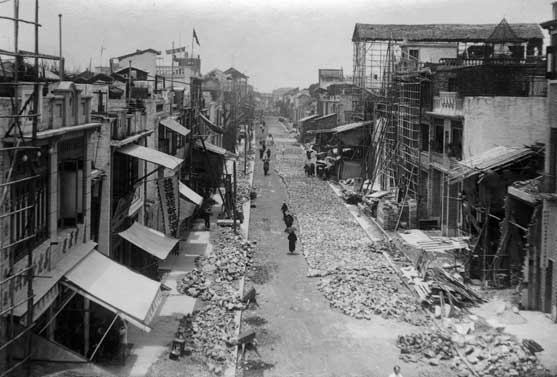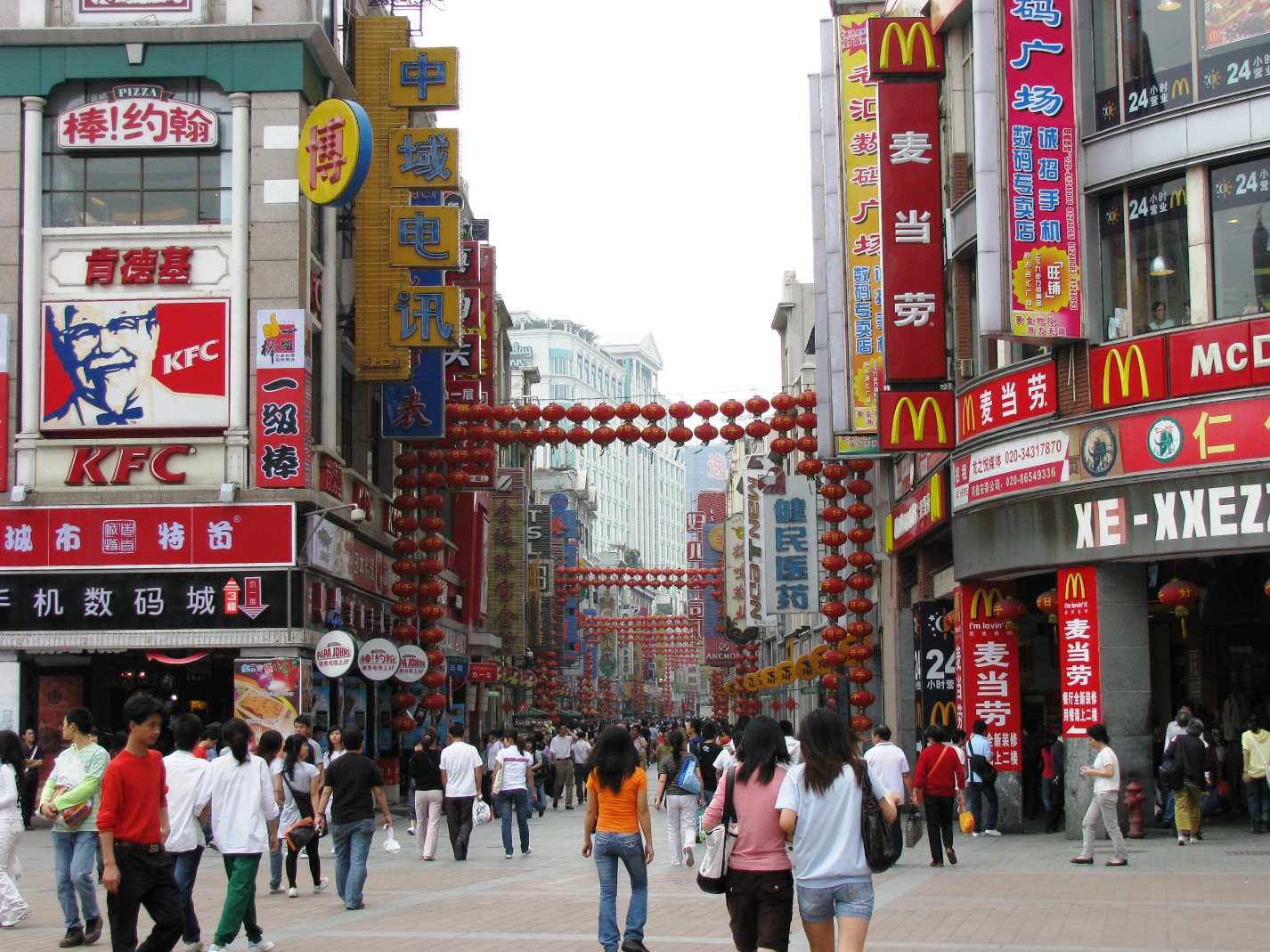|
Xiguan
Saikwan or Xiguan is an ancient town and an area in the Liwan district of Guangzhou, China, which was located west of the old walled city. The Thirteen Factories trading enclave was located on its southern shore and the Shamian enclave was constructed beside it. Xiguan continues to have a distinctive culture within Guangzhou and some residents speak a distinctive dialect of Cantonese. It now forms most of Liwan District. Name Before the 20th century, Guangzhou was a walled city with many gates. Its western gates included the Taiping Gate ''Tàipíngmén''; . "Gate of Great Peace") and the West Gate ''Zhengximén'', . "Straight Western Gate"). "Saikwan" or is a romanization of the local Cantonese pronunciation of the same Chinese characters. It was formerly the area's more common English name, although Mandarin pinyin is now the official form within China. It was also sometimes simply translated as "Westgate" or the "western suburbs" of Guangzhou (formerly known ... [...More Info...] [...Related Items...] OR: [Wikipedia] [Google] [Baidu] |
Liwan District
Liwan District is one of 11 urban districts of the prefecture-level city of Guangzhou, the capital of Guangdong Province, China. The district is split into two parts by the Pearl River: Xiguan in the northeast and Fangcun in the southwest. History Liwan District was named after "Lizhiwan", which is derived from poem of "a bay of green water and red lychees along both banks". It covers an area of and has a permanent population of about 540,000 and a permanent nonnative population of over 200,000. Liwan District is positioned in the flourishing west part of Guangzhou, on the northeast bank of the Pearl River. Liwan was originally a western suburb of Guangzhou known as Xiguan and Huadai/Huadi located in between two counties of Panyu County and Nanhai County. On 15 February 1921 Liwan along with Guangfu (present Yuexiu) formed the City of Guangzhou. Fangcun, in the western part of Liwan District, lay at the southwest of Guangzhou's downtown area and south of Pearl River. ... [...More Info...] [...Related Items...] OR: [Wikipedia] [Google] [Baidu] |
Lychee Bay
Lychee Bay or Litchi Bay (), a set of creeks and lakes that flow southwest to Pearl River, is a tourist attraction in Guangzhou (Canton), Guangdong. Liwan District, where Lychee Bay is located, was named after it. There are many historical relics and historical architectures in Lychee Bay, such as Wenta and Xiguan House. Various cultural activities are held on Lychee Bay, such as the Cantonese opera competition. Geography Lychee Bay is located in Xiguan, Liwan District, Guangzhou. In the past, it usually referred to a large area from Sima Creek () to Huangsha (). It is a drainage system composed of several creeks, including Xiguan and Liwan Creeks, flowing into the Pearl River. This is called the old Lychee Bay () now. In a modern context, Lychee Bay usually refers to the segment of Xiguan Creek from Pantong () to the Pearl River, which is part of the old Lychee Bay. History Origin of Lychee Bay Lychee Bay's history dates back to 2,200 years ago. In 206 BC, the Han emperor ask ... [...More Info...] [...Related Items...] OR: [Wikipedia] [Google] [Baidu] |
Thirteen Factories
The Thirteen Factories, also known as the , was a neighbourhood along the Pearl River in southwestern Guangzhou (Canton) in the Qing Empire from to 1856 around modern day Xiguan, in Guangzhou's Liwan District. These warehouses and stores were the principal and sole legal site of most Western trade with China from 1757 to 1842. The factories were destroyed by fire in 1822 by accident, in 1841 amid the First Opium War, and in 1856 at the onset of the Second Opium War. The factories' importance diminished after the opening of the treaty ports and the end of the Canton System under the terms of the 1842 Anglo-Chinese Treaty of Nanking. After the Second Opium War, the factories were not rebuilt at their former site south of Guangzhou's old walled city but moved, first to Henan Island across the Pearl River and then to Shamian Island south of Guangzhou's western suburbs. Their former site is now part of . Terminology The "factories" were not workshops or manufacturing cent ... [...More Info...] [...Related Items...] OR: [Wikipedia] [Google] [Baidu] |
Guangzhou
Guangzhou (, ; ; or ; ), also known as Canton () and alternatively romanized as Kwongchow or Kwangchow, is the capital and largest city of Guangdong province in southern China. Located on the Pearl River about north-northwest of Hong Kong and north of Macau, Guangzhou has a history of over 2,200 years and was a major terminus of the maritime Silk Road; it continues to serve as a major port and transportation hub as well as being one of China's three largest cities. For a long time, the only Chinese port accessible to most foreign traders, Guangzhou was captured by the British during the First Opium War. No longer enjoying a monopoly after the war, it lost trade to other ports such as Hong Kong and Shanghai, but continued to serve as a major transshipment port. Due to a high urban population and large volumes of port traffic, Guangzhou is classified as a Large-Port Megacity, the largest type of port-city in the world. Due to worldwide travel restrictions at the beginni ... [...More Info...] [...Related Items...] OR: [Wikipedia] [Google] [Baidu] |
Cantonese Language
Cantonese ( zh, t=廣東話, s=广东话, first=t, cy=Gwóngdūng wá) is a language within the Chinese (Sinitic) branch of the Sino-Tibetan languages originating from the city of Guangzhou (historically known as Canton) and its surrounding area in Southeastern China. It is the traditional prestige variety of the Yue Chinese dialect group, which has over 80 million native speakers. While the term ''Cantonese'' specifically refers to the prestige variety, it is often used to refer to the entire Yue subgroup of Chinese, including related but largely mutually unintelligible languages and dialects such as Taishanese. Cantonese is viewed as a vital and inseparable part of the cultural identity for its native speakers across large swaths of Southeastern China, Hong Kong and Macau, as well as in overseas communities. In mainland China, it is the ''lingua franca'' of the province of Guangdong (being the majority language of the Pearl River Delta) and neighbouring areas such as Guangx ... [...More Info...] [...Related Items...] OR: [Wikipedia] [Google] [Baidu] |
Shangxiajiu
Shangxiajiu Pedestrian Street (), or simply as Shangxiajiu (), is a commercial pedestrian street in Liwan District, Guangzhou, Guangdong, China. It is the first business street in Guangzhou, and it opened in September 1995. Location Located in the old town of Xiguan (), it stretches from Shangjiu Road () and Xiajiu Road () in the east to Dishifu Road () in the west, and traverses Baohua Road () and Wenchang Road (), about long with more than 300 shops. Shangxiajiu is composed of the unique and historical architecture based on and |
List Of Chinese Dynasties
Dynasties in Chinese history, or Chinese dynasties, were hereditary monarchical regimes that ruled over China during much of its history. From the legendary inauguration of dynastic rule by Yu the Great circa 2070 BC to the abdication of the Xuantong Emperor on 12 February 1912 in the wake of the Xinhai Revolution, China was ruled by a series of successive dynasties. Dynasties of China were not limited to those established by ethnic Han—the dominant Chinese ethnic group—and its predecessor, the Huaxia tribal confederation, but also included those founded by non-Han peoples. Dividing Chinese history into periods ruled by dynasties is a convenient method of periodization. Accordingly, a dynasty may be used to delimit the era during which a family reigned, as well as to describe events, trends, personalities, artistic compositions, and artifacts of that period. For example, porcelain made during the Ming dynasty may be referred to as "Ming porcelain". The word "dynasty" is u ... [...More Info...] [...Related Items...] OR: [Wikipedia] [Google] [Baidu] |
Shamian Island
Shamian (also romanized as Shameen or Shamin, both from its Cantonese pronunciation) is a sandbank island in the Liwan District of Guangzhou, Guangdong, China. The island's name literally means "sandy surface" in Chinese. The territory was divided into two concessions given to France and the United Kingdom by the Qing government in the 19th century (1859 to 1943). The island is a gazetted historical area that serves as a tranquil reminder of the colonial European period, with quiet pedestrian avenues flanked by trees and lined by historical buildings in various states of upkeep. The island is the location of several hotels, a youth hostel, restaurants and tourist shops selling curios and souvenirs. Geography The island covers an area of 0.3 km², 900 m from east to west, and 300 m from north to south. It is bordered in the south by the Pearl River, and it is separated from the mainland by a canal. History Shamian Island was an important port for Guangzhou's forei ... [...More Info...] [...Related Items...] OR: [Wikipedia] [Google] [Baidu] |
Ming Dynasty
The Ming dynasty (), officially the Great Ming, was an Dynasties in Chinese history, imperial dynasty of China, ruling from 1368 to 1644 following the collapse of the Mongol Empire, Mongol-led Yuan dynasty. The Ming dynasty was the last orthodox dynasty of China ruled by the Han Chinese, Han people, the majority ethnic group in China. Although the primary capital of Beijing fell in 1644 to a rebellion led by Li Zicheng (who established the short-lived Shun dynasty), numerous rump state, rump regimes ruled by remnants of the House of Zhu, Ming imperial family—collectively called the Southern Ming—survived until 1662. The Ming dynasty's founder, the Hongwu Emperor (r. 1368–1398), attempted to create a society of self-sufficient rural communities ordered in a rigid, immobile system that would guarantee and support a permanent class of soldiers for his dynasty: the empire's standing army exceeded one million troops and the naval history of China, navy's dockyards in Nanjin ... [...More Info...] [...Related Items...] OR: [Wikipedia] [Google] [Baidu] |
Bo Wah Road
Bo or BO may refer to Arts and entertainment Film, television, and theatre *Box office, where tickets to an event are sold, and by extension, the amount of business a production receives *''BABO, BA:BO'', 2008 South Korean film *Bo (film), ''Bo'' (film), a Belgian film starring Ella-June Henrard and directed by Hans Herbots Gaming *''Call of Duty: Black Ops'', a first-person shooter video game *''Blood Omen: Legacy of Kain'', first in the Legacy of Kain video game series Music *Bo (instrument), a Chinese cymbal *w:el:Bo (ράπερ), Bo, a Greek rapper. Religion *Bo or Bodhi Tree *Bo (parsha), fifteenth weekly Torah reading Ethnic groups *Bo people (China), a nearly extinct minority population in Southern China *Bo people of Laos, see List of ethnic groups in Laos *Bo people (Andaman), a recently extinct group in the Andaman Islands Human names *Bo (given name), name origin, plus a list of people and fictional characters with the name or nickname *Bo (surname), name origin ... [...More Info...] [...Related Items...] OR: [Wikipedia] [Google] [Baidu] |
Nanhai County
Nanhai County was a former county in Guangdong Province, China, named after the South China Sea. Its former area now makes up Nanhai District in Foshan and Liwan District in Guangzhou Guangzhou (, ; ; or ; ), also known as Canton () and alternatively romanized as Kwongchow or Kwangchow, is the capital and largest city of Guangdong province in southern China. Located on the Pearl River about north-northwest of Hong Kon .... See also * References Former counties of China Liwan District Nanhai District History of Guangdong {{PRChina-geo-stub ... [...More Info...] [...Related Items...] OR: [Wikipedia] [Google] [Baidu] |






